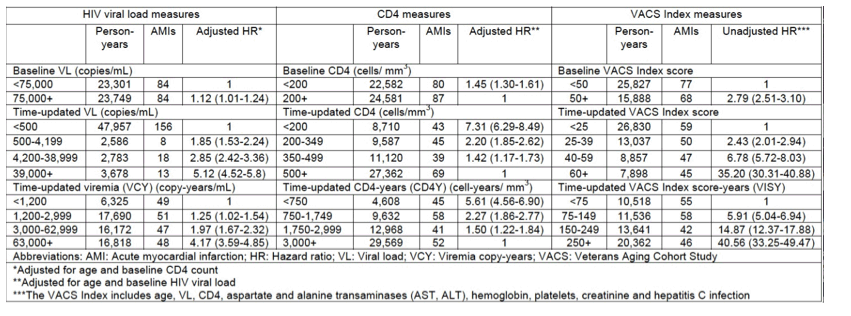 |
 |
 |
| |
More time with high viral load, high VACS index, predicts MI in veterans HIV cohort, as well as time-updated viral load & CD4
|
| |
| |
CROI 2015, February 23-26, 2015, Seattle, Washington
"cumulative measures of viremia......implies that immediate viral control in newly diagnosed people will help protect them from MI......noncumulative measures also predicted MI.....Baseline viral load above vs below 100,000 52% increased risk......Time-updated viremia: 200-2999 copies vs under 25: HR 2.00.....Time-updated CD4 count 185-319 vs 475+: HR 1.72 (72% increased risk)Ó
Mark Mascolini
Higher viremia copy-year--a cumulative measure of detectable viral load over time--doubled chances of myocardial infarction (MI) in an analysis of HIV-positive antiretroviral-treated veterans in the Veterans Aging Cohort Study Virtual Cohort (VACS-VC) [1]. Higher VACS Index score, a validated measure of all-cause mortality in HIV-positive people, also predicted MI in this analysis.
Studies show that people with HIV have a 50% to 75% higher MI risk than people without HIV after accounting for traditional risk factors, noted Jorge Salinas (Emory University) and colleagues from other centers who conducted this study. MI risk factors in HIV populations are usually assessed in cross-sectional analyses. Salinas and colleagues hypothesized that cumulative measures of viral load, CD4 count, and VACS Index would yield new insights into MI incidence.
To test this hypothesis, they conducted a retrospective analysis of HIV-positive VACS-VC veterans in care in from 2000 to 2012. For each veteran the investigators calculated (1) viremia copy-years, a cumulative measure of time spent with a detectable viral load, similar to pack-years smoking; (2) CD4-years, a cumulative measure of CD4 count; and (3) VACS Index score-years, a cumulative measure of the VACS score, which sums points for age, CD4 count, viral load, hemoglobin, platelets, aspartate and alanine aminotransferase, creatinine, and HCV infection [2]. The researchers charted cumulative measures starting 6 months after antiretroviral therapy began until acute MI, death, the last clinic visit, or the end of the study period. The primary outcome was acute MI determined by Medicare records or VA ICD-9 codes.
Salinas and colleagues broke all three cumulative measures into quartiles: for viremia copy-years 113,000+ copy-years, 14,000 to 112,999, 600 to 13,999, and under 600; for CD4-years 2700+ CD4-years, 1500 to 2699, 815 to 1499, and under 815; for VACS score-years 265+ VACS score-years, 150 to 264, 85 to 149, and under 85. They also analyzed the impact of baseline viral load, CD4 count, and VACS Index score and time-updated viral load, CD4 count, and VACS Index score.
The analysis included 8173 veterans, 163 of whom (2%) had an MI during follow-up. Cox proportional hazard models determined that higher quartiles of viremia copy-years and VACS score-years--but not CD4-years--independently predicted higher MI risks at the following hazard ratios (HR) (and 95% confidence intervals):
-- Viremia copy-years, highest vs lowest quartile: HR 2.61 (1.63 to 4.36)
-- Viremia copy-years, second highest vs lowest quartile: HR 2.38 (1.51 to 3.74)
-- Viremia copy-years, third highest vs lowest quartile: HR 1.90 (1.21 to 2.97)
-- VACS score-years, highest vs lowest quartile: HR 4.13 (2.20 to 7.75)
-- VACS score-years, second highest vs lowest quartile: HR 2.62 (1.54 to 4.46)
-- VACS score-years, third highest vs lowest quartile: HR 2.11 (1.32 to 3.38)
Several noncumulative measures also predicted MI:
-- Baseline viral load above vs below 100,000: HR 1.52 (1.10 to 2.11)
-- Time-updated viremia: 200-2999 copies vs under 25: HR 2.00 (1.24 to 3.22)
-- Time-updated CD4 count 185-319 vs 475+: HR 1.72 (1.13 to 2.61)
-- Time-updated CD4 count below 185 vs 475+: HR 1.60 (1.02 to 2.51)
-- Time-updated VACS score: 55+ vs below 20: HR 3.77 (2.33 to 6.11)
The researchers concluded that "cumulative measures of viremia and VACS Index score provide added information about the risk of acute MI in people living with HIV." Cumulative VACS score offered the "most robust added information." The cumulative viremia finding implies that immediate viral control in newly diagnosed people will help protect them from MI.
from abstract:

References
1. Salinas J, Marconi V, Rimland D, et al. Cumulative HIV care measures highly associated with acute myocardial infarction. CROI 2015. February 23-26, 2015. Seattle, Washington. Abstract 746.
2. Yale.edu. VACS applications. http://vacs.med.yale.edu/
|
| |
|
 |
 |
|
|